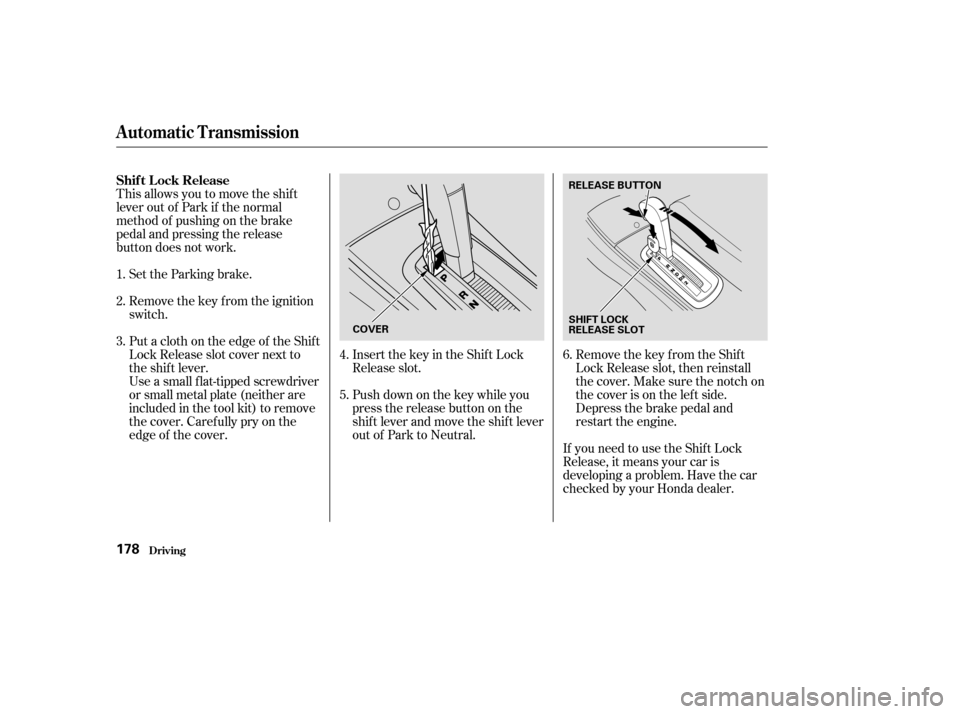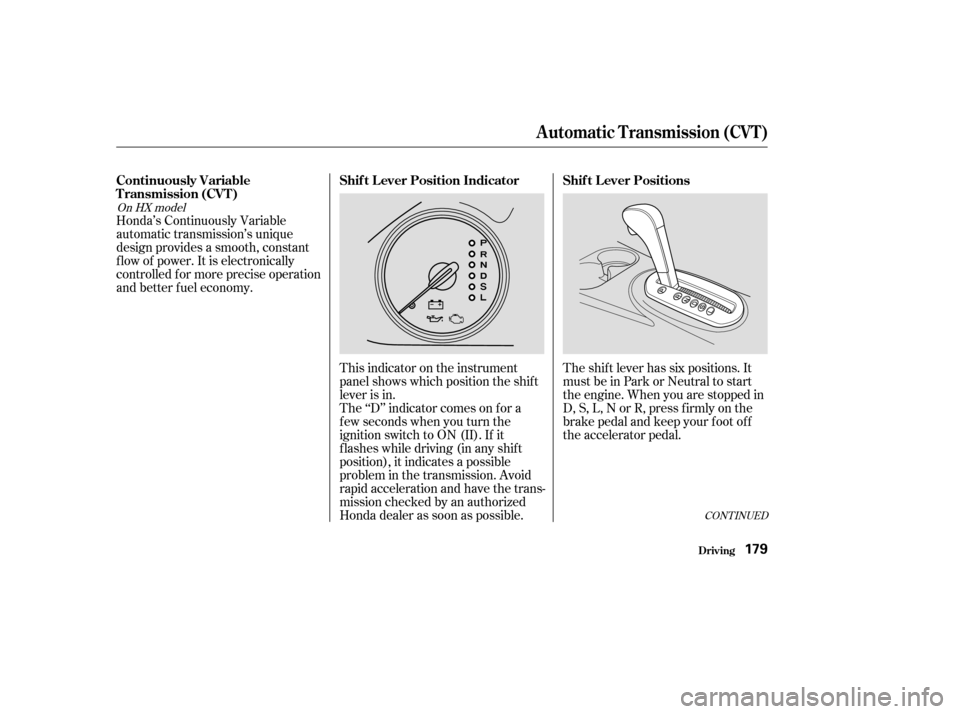Page 172 of 302

This allows you to move the shif t
lever out of Park if the normal
method of pushing on the brake
pedal and pressing the release
button does not work.Set the Parking brake.
Remove the key from the ignition
switch.
Push down on the key while you
pressthereleasebuttononthe
shif t lever and move the shif t lever
out of Park to Neutral.
Insert the key in the Shift Lock
Release slot.
Put a cloth on the edge of the Shif t
Lock Release slot cover next to
the shift lever.
Use a small flat-tipped screwdriver
or small metal plate (neither are
included in the tool kit) to remove
the cover. Caref ully pry on the
edge of the cover. Remove the key from the Shift
Lock Release slot, then reinstall
thecover.Makesurethenotchon
the cover is on the lef t side.
Depress the brake pedal and
restart the engine.
If you need to use the Shif t Lock
Release, it means your car is
developing a problem. Have the car
checked by your Honda dealer.
1. 2. 3.
4.5.6.
Automatic Transmission
Driving
Shif t L ock Release
178
COVER
SHIFT LOCK
RELEASE SLOT
RELEASE BUTTON
�����—�����—�����y�
���������
���y���
�(���%�������y���
���
�y
Page 173 of 302

Honda’s Continuously Variable
automatic transmission’s unique
design provides a smooth, constant
f low of power. It is electronically
controlled f or more precise operation
and better f uel economy.This indicator on the instrument
panel shows which position the shif t
lever is in.
The ‘‘D’’ indicator comes on f or a
f ew seconds when you turn the
ignition switch to ON (II). If it
f lashes while driving (in any shif t
position), it indicates a possible
problem in the transmission. Avoid
rapid acceleration and have the trans-
mission checked by an authorized
Honda dealer as soon as possible.The shif t lever has six positions. It
must be in Park or Neutral to start
the engine. When you are stopped in
D, S, L, N or R, press f irmly on the
brake pedal and keep your f oot of f
the accelerator pedal.
CONT INUED
On HX model
Continuously Variable
T ransmission (CVT )
Shif t L ever Position Indicator Shif t L ever Positions
Automatic Transmission (CVT)
Driving179
�����—�����—�
���y�
���������
���y���
�(���%�������y���
�����y
Page 174 of 302
�µDo this:
Press the brake pedal and
press the release button.
Press the release button.
Move the lever.
To shift from:
PtoR
RtoP
NtoR StoL
LtoS
StoD
DtoS
DtoN
NtoD RtoNThis position
mechanically locks the transmission.
Use Park whenever you are turning
of f or starting the engine. To shif t
outofPark,youmustpressonthe
brake pedal, have your foot off the
accelerator pedal, and press the
releasebuttononthefrontof the
shif t lever.
If you have done all of the above and
still cannot move the lever out of
Park, see Shif t Lock Release on page .
You must also press the release
button to shift into Park. To avoid
transmission damage, come to a
complete stop before shifting into
Park. The shif t lever must be in Park
bef ore you can remove the key f rom
the ignition switch.
178
Automatic Transmission (CVT)
Driving
Park (P)
180
�����—�����—�
���y�
�������������y���
�(���%�������y���
�����y
Page 175 of 302

�µ
�µ �µ
�µ �µ
To shift from Re-
verse to Park, see the explanation
under Park. To shif t to Reverse f rom
Neutral, come to a complete stop
first. Press the release button before
shifting into Reverse from Neutral.
Use Neutral if you
need to restart a stalled engine, or if
it is necessary to stop brief ly with
the engine idling. Always shif t to
Park position if you need to leave the
vehicle for any reason. Press on the
brake pedal when you are moving
the shift lever from Neutral to
another position. Use this position f or
your normal driving. The transmis-
sion automatically adjusts to keep
the engine at the best speed f or
driving conditions. To help the
engine warm up f aster, the transmis-
sion will select ratios that allow the
engine to run at higher speeds when
it is cold.
Selecting Second
shifts the transmission into a lower
range of ratios f or better accelera-
tion and increased engine braking.
Use Second when you are going
down a steep hill, or in stop-and-go
driving. ForfasteraccelerationwheninD,S
or L, the transmission will
automatically ‘‘kick down’’ to a lower
range of ratios by pushing the
accelerator pedal to the floor.
The CVT shifts automatically to
maintain proper engine speed in any
shif t position.
When the vehicle reaches the
maximum speed in any shif t position,
you may f eel the engine cut in and
out. This is caused by a limiter (112
mph, 180 km/h) in the engine’s
computer controls. The engine will
run normally when you reduce the
speed to below the maximum.To shif t to Low, press
the release button on the front of the
shif t lever. Use Low to get more
power when climbing, and f or
maximum engine braking when
going down steep hills.
Automatic Transmission (CVT)
Driving
Reverse (R)
Neutral (N) Drive (D)
Second (S)
Maximum Allowable Speeds
Low (L)
181
�����—�����—�����y�
�������������y���
�(���%�������y���
�����y
Page 176 of 302

�µMake sure the moonroof and the
windows are closed.
Make sure the parking brake is f ully
released bef ore driving away.
Driving with the parking brake
partially set can overheat or damage
the rear brakes. Turn of f the lights.
Place any packages, valuables, etc.,
in the trunk or take them with you.
Lockthedoorswiththekeyorthe
remote transmitter.
Never park over dry leaves, tall
grass, or other f lammable
materials. The three way catalytic
converter gets very hot, and could
cause these materials to catch on
fire.
Always use the parking brake when
you park your car. The indicator on
the instrument panel shows that the
parking brake is not f ully released; it
does not indicate that the parking
brakeisfirmlyset.Makesurethe
parking brake is set f irmly or your
car may roll if it is parked on an
incline.
If your car has an automatic
transmission, set the parking brake
bef ore you put the transmission in
Park.Thiskeepsthecarfrom
moving and putting pressure on the
parking mechanism in the
transmission making it easier to
move the shift lever out of Park
when you want to drive away. If the car is f acing uphill, turn the
f ront wheels away f rom the curb. If
you have a manual transmission, put
it in f irst gear.
If the car is f acing downhill, turn the
f ront wheels toward the curb. If you
have a manual transmission, put it in
reverse gear.
Parking T ips
Driving
Parking
182
�����—�����—�����y�
�������������y���
�(���%�������y���
�����y
Page 194 of 302

�µ�µ�µ �µ
�µ
�µ
�µ
Engine oil level Check every
time you fill the fuel tank. See
page .
Engine coolant level Check the
radiator reserve tank every time
you f ill the f uel tank. See page .
Windshield washer f luid Check
the level in the reservoir monthly.
If weather conditions cause you to
use the washers f requently, check
the reservoir each time you stop
f or f uel. See page .
Youshouldcheckthefollowing
items at the specif ied intervals. If
you are unsure of how to perf orm
any check, turn to the page given.
Lights Check the operation of
the headlights, parking lights,
taillights, high-mount brake light,
turn signals, brake lights, and
license plate lights monthly. See
page .
Tires Check the tire pressure
monthly. Examine the tread f or
wear and foreign objects. See page
.
Automatic transmission Check
the f luid level monthly. See page .
Brakes Check the f luid level
monthly. See page . 160
161
213
214 217 232
239
Owner Maintenance Checks
Maint enance201
�����—�����—�����y�
�������������y���
�(���%�������y���������y
Page 195 of 302
Fluid Locations
Maint enance202
ENGINE OIL
FILL CAPBRAKE FLUID
(Gray cap)
CLUTCH FLUID
(Gray cap)
WASHER FLUID
(Blue cap)
POWER STEERING
FLUID (Red cap)
AUTOMATIC
TRANSMISSION FLUID
DIPSTICK (CVT)
(Yellow loop)
RADIATOR CAP
ENGINE
COOLANT
RESERVOIR ENGINE OIL DIPSTICK
(Orange loop)
AUTOMATIC
TRANSMISSION
FLUID DIPSTICK
(Yellow loop)
�����—�����—�����y�
���������
���y���
�(���%�������y���������y
Page 204 of 302
Tightening torque:
When the coolant stops draining,
tightenthedrainpluginthe
bottom of the radiator. Apply non-
hardening sealant to the drain bolt
threads, put a new washer on the
drain bolt, and reinstall the drain
bolt in the engine block. Tighten it
securely.
Pour Honda All Season
Antif reeze/Coolant Type 2 into
the radiator up to the base of the
f iller neck. This coolant is a
mixture of 50 percent antif reeze
and 50 percent water. Pre-mixing
is not required.The cooling system capacity is:
10.
11.
CONT INUED
With 5-speed manual transmission:With automatic transmission:With automatic transmission (CVT):
Cooling Syst em
Maint enance211
Fill up to here
FILLER NECK
58 lbf·ft (78 N·m , 8.0 kgf·m)
1.03 US gal (3.9
)
1.00 US gal (3.8
)
1.00 US gal (3.8
)
�����—�����—�����y�
�������������y���
�(���%�������y�����
���y